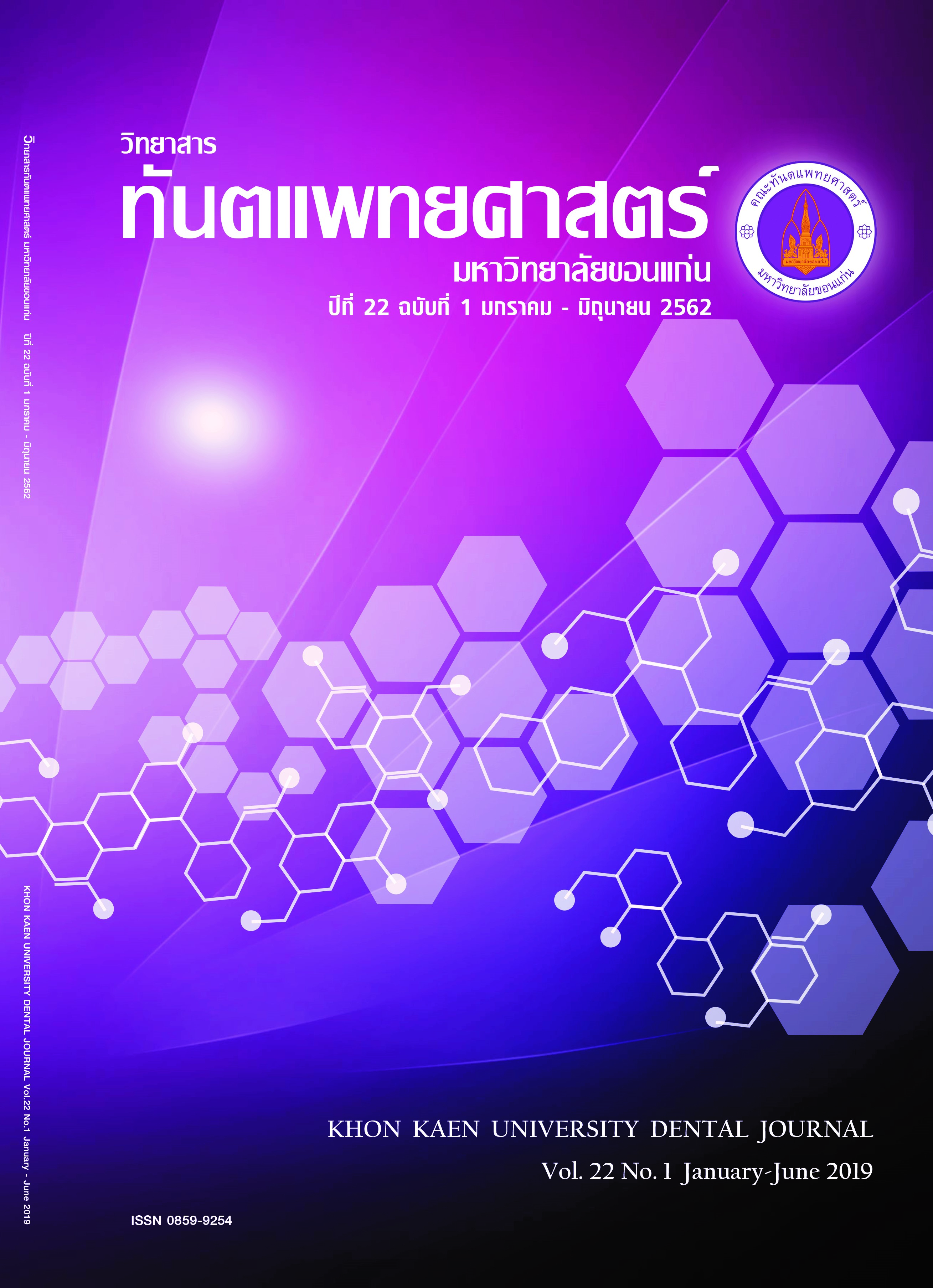The Comparison of Flexural Strength of Provisional Restoration with and without Reinforcement between Self-cure Acrylic Resin and Bis-acrylic Based Composite Resins
Main Article Content
Abstract
The aim of this study was to evaluate the flexural strength of polymethyl methacrylate (Unifast®) polyethyl methacrylate (Dentalon®) and composite resin (Protemp4TM) with and without glass fiber reinforcement (everStick®) at 0 day 7, and 14 days. A total of 162 rectangular specimens (25x2x2 mm.) were prepared. The specimens were divided into 6 groups according to type of materials with glass fiber reinforcement and without reinforcement as a control group. A standard three-point bending test was conducted on the specimens using a universal testing machine at a crosshead speed of 0.5 mm/min after immediate completed polymerization and storage in artificial saliva for 7 and 14 days. The mean values of flexural strength of each provisional material were calculated in N/mm2 and analyzed using the factorial ANOVA and independent t-test (p<0.05). The analysis of Factorial ANOVA test shows that there was statistically significant difference in the flexural strength values of the six groups (p < 0.05). Materials, fiber reinforcement and time have significant effects on the mean flexural strength (p<0.05) and there was a significant interaction among these three factors. For reinforced groups, the mean flexural strength of Unifast® increased from 87.48±5.52 MPa to 97.12±5.54 MPa at 0 day, 92.48±4.79 MPa to 118.32±5.60 MPa at 7 day and 85.65±3.14 to 129.51±5.58 MPa at 14 days. The mean flexural strength of Dentalon® increased from 58.19±4.77 MPa to 89.52±5.81 MPa at 0 day, 71.39±3.78 MPa to 77.24±4.92 MPa at 7 days and 67.67±5.47 to 77.21±5.51 MPa at 14 days. According to the pairwise comparison of Independent t-test, flexural strength values of Unifast® and Dentalon® with reinforcement were higher and statistically significant than those of the Unifast® and Dentalon® without reinforcement (p<0.05). For Protemp4TM, the mean flexural strength increased from 63.84 ±
4.49 MPa to 64.42±4.56 MPa at day 0, 89.61±4.69 MPa to 102.69±5.53 MPa at 7 days and decreased from 110.25±5.59 to 95.03±5.59 MPa. However, there was no significant difference between flexural strength values of Protemp4TM with reinforcement and without reinforcement group (p<0.05) at 0 day and 14 days. Although impregnated glass fiber increased the flexural strength of both PMMA, PEMA and BAC groups, it was significantly higher for PMMA and PEMA resin.
Article Details
บทความ ข้อมูล เนื้อหา รูปภาพ ฯลฯ ที่ได้รับการลงตีพิมพ์ในวิทยาสารทันตแพทยศาสตร์ มหาวิทยาลัยขอนแก่นถือเป็นลิขสิทธิ์เฉพาะของคณะทันตแพทยศาสตร์ มหาวิทยาลัยขอนแก่น หากบุคคลหรือหน่วยงานใดต้องการนำทั้งหมดหรือส่วนหนึ่งส่วนใดไปเผยแพร่ต่อหรือเพื่อกระทำการใด ๆ จะต้องได้รับอนุญาตเป็นลายลักษณ์อักษร จากคณะทันตแพทยศาสตร์ มหาวิทยาลัยขอนแก่นก่อนเท่านั้น
References
Luthardt RG, Stossel M, Hinz M, Vollandt R. Clinical performance and periodontal outcome of temporary crowns and fixed partial dentures: A randomized clinical trial. J Prosthet Dent 2000;83(1):32-9.
Balkenhol M, Mautner MC, Ferger P, Wostmann B. Mechanical properties of provisional crown and bridge materials: chemical-curing versus dual-curing systems. J Dent 2008;36(1):15-20.
Christensen GJ. Provisional restorations for fixed prosthodontics. J Am Dent Assoc 1996;127(2):249-52.
Hernandez EP, Oshida Y, Platt JA, et al. Mechanical properties of four methylmethacrylate-based resins for provisional fixed restorations. Biomed Mater Eng 2004;14(1):107-22.
Gratton DG, Aquilino SA. Interim restorations. Dent Clin North Am 2004;48(2):vii, 487-97.
Strassler HE. Fixed prosthodontics provisional materials: making the right selection. Compend Contin Educ Dent 2013;34(1):22-4, 26; quiz 28, 30.
Jo LJ, Shenoy KK, Shetty S. Flexural strength and hardness of resins for interim fixed partial dentures. Indian J Dent Res 2011;22(1):71-6.
Hazelton LR, Nicholls JI, Brudvik JS, Daly CH. Influence of reinforcement design on the loss of marginal seal of provisional fixed partial dentures. Int J Prosthodont 1995;8(6):572-9.
Vallittu PK. Comparison of the in vitro fatigue resistance of an acrylic resin removable partial denture reinforced with continuous glass fibers or metal wires. J Prosthodont 1996;5(2):115-21.
Vallittu PK. Comparison of two different silane compounds used for improving adhesion between fibres and acrylic denture base material. J Oral Rehabil 1993;20(5):533-9.
Pollack RP. Non-crown and bridge stabilization of severely mobile, periodontally involved teeth. A 25-year perspective. Dent Clin North Am 1999;43(1):77-103.
Osman YI, Owen CP. Flexural strength of provisional restorative materials. J Prosthet Dent 1993;70(1):94-6.
New American Dental Association specification no. 27 for direct filling resins. Council on Dental Materials and Devices. J Am Dent Assoc 1977;94(6):1191-4.
Al Twal EQ, Chadwick RG. Fibre reinforcement of two temporary composite bridge materials--effect upon flexural properties. J Dent 2012;40(12):1044-51.
Fahmy NZ, Sharawi A. Effect of two methods of reinforcement on the fracture strength of interim fixed partial dentures. J Prosthodont 2009;18(6):512-20.
Lang R, Rosentritt M, Behr M, Handel G. Fracture resistance of PMMA and resin matrix composite-based interim FPD materials. Int J Prosthodont 2003;16(4):381-4.
Floyd CJ, Dickens SH. Network structure of Bis-GMA- and UDMA-based resin systems. Dent Mater 2006;22(12):1143-9.
Ewoldsen N, Sundar V, Bennett W, Kanya K, Magyar K. Clinical evaluation of a visible light-cured indirect composite for long-term provisionalization. J Clin Dent 2008;19(1):37-41.
Poonacha V, Poonacha S, Salagundi B, Rupesh PL, Raghavan R. In vitro comparison of flexural strength and elastic modulus of three provisional crown materials used in fixed prosthodontics. J Clin Exp Dent 2013;5(5):e212-7.
Samadzadeh A, Kugel G, Hurley E, Aboushala A. Fracture strengths of provisional restorations reinforced with plasma-treated woven polyethylene fiber. J Prosthet Dent 1997;78(5):447-50.


